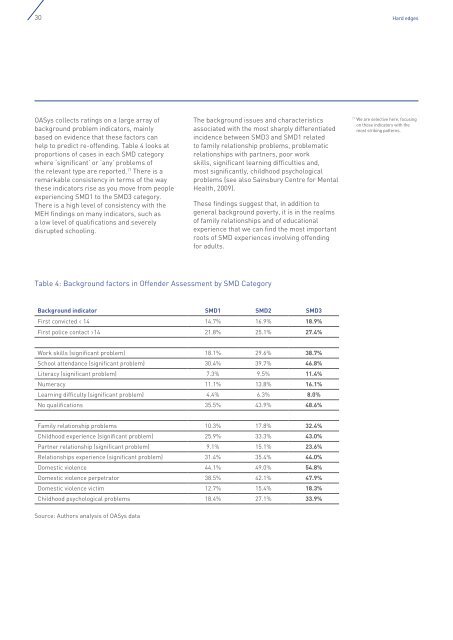Hard_Edges_Mapping_SMD_FINAL_VERSION_Web
Hard_Edges_Mapping_SMD_FINAL_VERSION_Web
Hard_Edges_Mapping_SMD_FINAL_VERSION_Web
You also want an ePaper? Increase the reach of your titles
YUMPU automatically turns print PDFs into web optimized ePapers that Google loves.
30 <strong>Hard</strong> edges<br />
OASys collects ratings on a large array of<br />
background problem indicators, mainly<br />
based on evidence that these factors can<br />
help to predict re-offending. Table 4 looks at<br />
proportions of cases in each <strong>SMD</strong> category<br />
where ‘significant’ or ‘any’ problems of<br />
the relevant type are reported. 17 There is a<br />
remarkable consistency in terms of the way<br />
these indicators rise as you move from people<br />
experiencing <strong>SMD</strong>1 to the <strong>SMD</strong>3 category.<br />
There is a high level of consistency with the<br />
MEH findings on many indicators, such as<br />
a low level of qualifications and severely<br />
disrupted schooling.<br />
The background issues and characteristics<br />
associated with the most sharply differentiated<br />
incidence between <strong>SMD</strong>3 and <strong>SMD</strong>1 related<br />
to family relationship problems, problematic<br />
relationships with partners, poor work<br />
skills, significant learning difficulties and,<br />
most significantly, childhood psychological<br />
problems (see also Sainsbury Centre for Mental<br />
Health, 2009).<br />
These findings suggest that, in addition to<br />
general background poverty, it is in the realms<br />
of family relationships and of educational<br />
experience that we can find the most important<br />
roots of <strong>SMD</strong> experiences involving offending<br />
for adults.<br />
17<br />
We are selective here, focusing<br />
on those indicators with the<br />
most striking patterns.<br />
Table 4: Background factors in Offender Assessment by <strong>SMD</strong> Category<br />
Background indicator <strong>SMD</strong>1 <strong>SMD</strong>2 <strong>SMD</strong>3<br />
First convicted < 14 14.7% 16.9% 18.9%<br />
First police contact >14 21.8% 25.1% 27.4%<br />
Work skills (significant problem) 18.1% 29.6% 38.7%<br />
School attendance (significant problem) 30.4% 39.7% 46.8%<br />
Literacy (significant problem) 7.3% 9.5% 11.4%<br />
Numeracy 11.1% 13.8% 16.1%<br />
Learning difficulty (significant problem) 4.4% 6.3% 8.0%<br />
No qualifications 35.5% 43.9% 48.6%<br />
Family relationship problems 10.3% 17.8% 32.4%<br />
Childhood experience (significant problem) 25.9% 33.3% 43.0%<br />
Partner relationship (significant problem) 9.1% 15.1% 23.6%<br />
Relationships experience (significant problem) 31.4% 35.4% 44.0%<br />
Domestic violence 44.1% 49.0% 54.8%<br />
Domestic violence perpetrator 38.5% 42.1% 47.9%<br />
Domestic violence victim 12.7% 15.4% 18.3%<br />
Childhood psychological problems 18.4% 27.1% 33.9%<br />
Source: Authors analysis of OASys data


